List of towns and cities in Norway
 From Wikipedia - Reading time: 14 min
From Wikipedia - Reading time: 14 min

This is a list of towns and cities in Norway. The Norwegian language word by means a town or city–there is no distinction between the two words as there is in English. Historically, the designation of town/city was granted by the king, but since 1996 that authority was given to the local municipal councils for each municipality in Norway. In Norway today, there are 108 towns/cities, but they have no legal authority or powers and they are not an administrative body, it is simply a designation. All local government rests with the municipality which may or may not have a town/city located within it.[1]
History
[edit]Historically, the words kjøpstad (market town), ladested (small seaport), or bergstad were used for a town or city. Each of these were granted certain special rights based on their classification and they did hold administrative authority within their borders. A ladested was subordinate to a kjøpstad and over time some of the ladesteds were "upgraded" to the status of kjøpstad in order to gain more trading rights. In 1665, Norway had 20 towns. There were 9 full market towns (kjøpstad): Bergen, Oslo, Trondheim, Tønsberg, Stavanger, Skien, Fredrikstad, Halden, and Kristiansand. There were two mountain towns {bergstad): Kongsberg and Røros. There were 9 market seaports (ladested): Larvik, Moss, Porsgrunn, Molde, Kragerø, Risør, Holmestrand, Mandal, and Drammen (which was actually 2 towns: Bragernes and Strømsø). All of the ladested places on this list were later upgraded to kjøpstads. During the 1800s, urbanization took hold in Norway and many new towns/cities were added. The special trading rights for towns/cities were abolished in 1857.[1]
In 1946, Norwegian municipalities were each assigned a municipality number, a four-digit codes based on ISO 3166-2:NO. Towns/cities got a municipality number in which the third digit was a zero and rural municipalities were given other numbers. In 1952 the special classifications of for towns/cities (kjøpstad, bergstad, and ladested) were entirely rescinded from the law and replaced by the simple classification of by. Starting on 1 January 1965, the government's focus was moved from the individual towns/cities to their corresponding municipalities. All Norwegian towns/cities and rural municipalities were classified as either a bykommune (urban municipality) or herredskommune (rural municipality). This distinction was rescinded by The Local Government Act of 1992.[1]
Between 1960 and 1965 many Norwegian municipalities were merged. For instance when the urban municipality Brevik merged with the urban municipality Porsgrunn and the rural municipality Eidanger, the new municipality was called Porsgrunn and it kept the municipality number for Porsgrunn. As a result, Brevik was no longer considered an urban municipality/town. On another note, when the urban municipality Hønefoss was merged with the rural municipalities Hole, Norderhov, Tyristrand, and Ådal to form the new municipality of Ringerike, Ringerike retained the old municipality number of Hønefoss meaning that it retained its town/city status. The same thing happened to Egersund and Florø.[2]
Before 1996, the city status was awarded by the king and Government through the Ministry of Local Government and Regional Development. Since then, the status of town/city is decided by each municipal council and then it is formally accepted by the state. Since 1997, a municipality must have a minimum of 5,000 inhabitants in order to declare city status for one of its settlements. In 1999, the municipal council of Bardu Municipality declared city status for Setermoen, only to be rejected because the municipality fell short of the population limit. One exception is Honningsvåg in Nordkapp Municipality, where the municipality actually has less than 5,000 inhabitants but declared city status before the limit was implemented by law in 1997.[3]
Because of the new laws in 1996-1997, Norway witnessed a rapid rise in the number of cities after that time. A number of relatively small settlements are now called by, such as Brekstad with 1,828 inhabitants and Kolvereid with 1,448 inhabitants. Among the cities of today which got this status before 1996, Tvedestrand with 1,983 inhabitants is the smallest. On another note, the laws of 1996 allowed some settlements which lost their city status in the 1960s to regain it.
Oslo, founded in the 11th century, is the largest city and also the capital of Norway. Oslo is the only city in Norway that is consolidated with its municipality and county, thus the city of Oslo, Oslo Municipality, and Oslo County are all one unified unit of government.[1]
Cities and towns in Norway
[edit]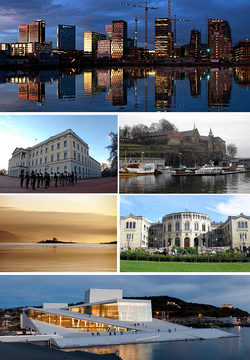

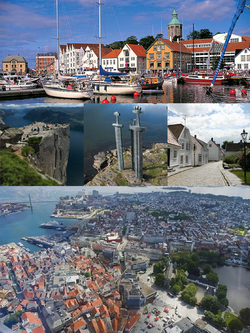
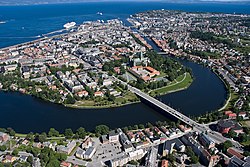

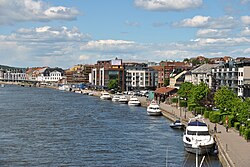
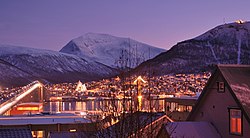





Former towns
[edit]| City | Municipality | County | Town status | Reason for lost status | ||
|---|---|---|---|---|---|---|
| Year | Type | Assigned by | ||||
| Holmsbu | Hurum Municipality | Buskerud | 1847–1964 | Ladested | Oscar I | Municipal merger |
| Hvitsten | Vestby Municipality | Akershus | 1837–1964 | Ladested | Karl III Johan | Municipal merger |
| Hølen | Vestby Municipality | Akershus | 1837–1943 | Ladested | Karl III Johan | Municipal merger |
| Setermoen | Bardu Municipality | Troms | 1999–1999 | By | Kommunestyre | Disallowed by government[3] |
| Sogndal | Sokndal Municipality | Rogaland | 1798–1944 | Ladested | Christian VII | Municipal merger |
| Son | Vestby Municipality | Akershus | 1604–1963 | Ladested | Christian IV | Municipal merger |
See also
[edit]- List of cities in Europe
- List of urban areas in Norway by population
- Lists of villages in Norway
- List of settlements in Svalbard and Jan Mayen
References
[edit]- ^ a b c d Thorsnæs, Geir, ed. (2024-02-13). "Byer i Norge". Store norske leksikon (in Norwegian). Kunnskapsforlaget. Retrieved 2024-02-24.
- ^ Jukvam, Dag (1999). Historisk oversikt over endringer i kommune- og fylkesinndelingen (PDF) (in Norwegian). Statistisk sentralbyrå. ISBN 9788253746845.
- ^ a b Kommunal Rapport (23 June 2005). "Byer i Norge". Archived from the original on 15 February 2006.
- ^ a b Greiner, Robert (2009-12-31). "2000–2009: Dette husker vi". NRK (in Norwegian). Retrieved 2024-02-19.
- ^ "Arendals historie". Arendal kommune (in Norwegian). 2016-02-04. Retrieved 2024-02-23.
- ^ a b c d e f g h i j k l m n o p q r s t u Holmquist, Tone (1997-09-05). "21 nye byer i Norge". Kommunal Rapport (in Norwegian). Retrieved 2024-02-19.
- ^ "Bardufoss får bystatus". NRK (in Norwegian). 2021-09-22. Retrieved 2024-07-16.
- ^ a b c d e f g h i j k l m n o p q r s t u v w x y z aa "Lov om opphevelse av foreldede lover". Lovdata.no (in Norwegian). Norges arbeids- og administrasjonsdepartementet. 1990-06-15. Retrieved 2024-02-20.
- ^ a b c d e f Soot-Ryen, Tron (2008-08-21). "Norges nye byer". NRK (in Norwegian). Retrieved 2024-02-19.
- ^ a b "Brevik and Kragerø". Norske Folkemuseum. Retrieved 2024-02-19.
- ^ Hoftun, Hanne (2009-01-12). "Brevik blir by". NRK (in Norwegian). Retrieved 2024-02-19.
- ^ a b Øyhovden, Asbjørn; Haugan, Olav (2010-06-24). "Brumunddal og Moelv får bystatus". TV 2 (in Norwegian). Retrieved 2024-02-19.
- ^ "Time kommune". NRK (in Norwegian). 2002-09-03. Retrieved 2024-02-19.
- ^ a b c d e f g Andreassen, Skjalg (2016-11-03). "De Eldste Byene". Vi som elsker Nord-Norge (in Norwegian).
- ^ "Kort oversikt over byens historie". Drammens historie (in Norwegian). 2004-07-06. Retrieved 2024-02-23.
- ^ a b c d "Jessheim er fylkets største tettsted uten bystatus". Romerikes Blad (in Norwegian). 2006-11-21. Retrieved 2024-02-20.
- ^ Kessel, Dag (2007-06-14). "Fagernes blir by" (in Norwegian). Retrieved 2024-02-19.
- ^ "Fauske fikk bystatus i 1998". altomfauske.no. Retrieved 2024-02-19.
- ^ "Fosnavåg". Historikk.com (in Norwegian). Retrieved 2024-02-19.
- ^ a b c Gabrielsen, Trond (2015-12-02). "Hevder handelsborgerne innvandret til Finnmark på 1500-tallet". Finnmark-Forlag (in Norwegian). Retrieved 2024-02-22.
- ^ "Hokksund blir by fra nyttår". NRK (in Norwegian). 2001-11-08. Retrieved 2024-02-19.
- ^ a b Thorsnæs, Geir, ed. (2024-02-21). "Holmestrand". Store norske leksikon (in Norwegian). Kunnskapsforlaget. Retrieved 2024-03-24.
- ^ "En by i vekst". Fremtidens By (in Norwegian). Retrieved 2024-02-19.
- ^ a b Thorsnæs, Geir, ed. (2024-02-21). "Kongsberg". Store norske leksikon (in Norwegian). Kunnskapsforlaget. Retrieved 2024-02-22.
- ^ a b c d Viseth, Sindre (2019). Fiskenæringens betydning for byutviklingen i Ålesund på 1800-tallet (PDF) (Master's thesis) (in Norwegian). University of Oslo. Retrieved 2024-02-21.
- ^ Sundsdal, Svein (2001-01-02). "Lyngdal - ny by på Sørlandet". NRK (in Norwegian). Retrieved 2024-02-20.
- ^ "Norsk Lovtidende. 2den Afdeling. 1922. Samling af Love, Resolutioner m.m". Norsk Lovtidend (in Norwegian). Oslo, Norway: Grøndahl og Søns Boktrykkeri: 277. 1922.
- ^ Sandmo, Espen; Haugen Egge, Julie (2014-06-30). "Velkommen til Ny Ork?". NRK (in Norwegian). Retrieved 2024-02-20.
- ^ "Raufoss fikk bystatus". NRK (in Norwegian). 2019-06-20. Retrieved 2024-02-23.
- ^ Hatland, Lena Erikke (2020-09-18). "Nå har Nærøysund to byer". Namdalsavisa (in Norwegian). Retrieved 2024-02-20.
- ^ "Sauda, Jørpeland og Bryne nye byer". Stavanger Aftenblad (in Norwegian). 2000-10-03. Retrieved 2024-02-20.
- ^ "Norsk Lovtidende. 2den Afdeling. 1946. Samling af Love, Resolutioner m.m". Norsk Lovtidend (in Norwegian). Oslo, Norway: Grøndahl og Søns Boktrykkeri: 190. 1946.
- ^ "Norsk Lovtidende. 2den Afdeling. 1918. Samling af Love, Resolutioner m.m". Norsk Lovtidend (in Norwegian). Oslo, Norway: Grøndahl og Søns Boktrykkeri: 127. 1918.
- ^ "Tynset får bystatus". NRK (in Norwegian). 2020-08-26. Retrieved 2025-05-23.
- ^ "Foto fra Ulsteinvik". Nordmørsmusea (in Norwegian). Retrieved 2024-02-21.
- ^ "Fakta om Verdal". Adresseavisen (in Norwegian). 2002-01-01. Retrieved 2024-02-21.
- ^ Holmquist, Tone (2013-09-02). "Nå er Vinstra by". Kommunal Rapport (in Norwegian). Retrieved 2024-02-21.
- ^ "Åsgårdstrand før og nå". Gjengangeren (in Norwegian). 2002-12-28. Retrieved 2024-02-21.
- ^ "Fakta og historie". Åsgårdstrand.no (in Norwegian). Retrieved 2024-02-21.
External links
[edit]- Map with Norwegian cities
- City Population: Norway (statistics & map) – Municipalities & Urban Settlements
 KSF
KSF